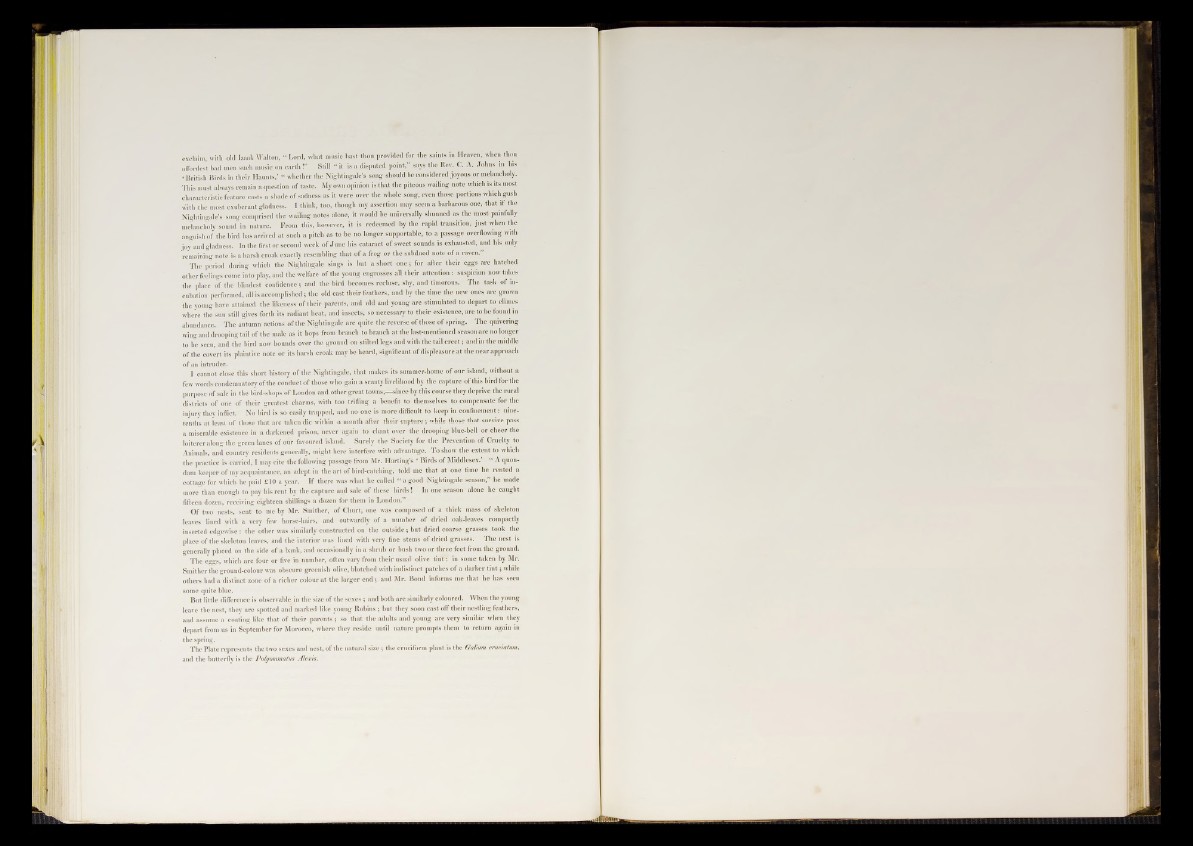
exclaim, with old Izaak Walton, “ Lord, what music hast thou provided for the saints in Heaven, when thou
affordest had men such music on earth !” Still “ it is a disputed point,” says the Rev, C. A. Johns In his
• British Birds in their Haunts,’ “ whether the Nightingale’s song should be considered joyous or melancholy.
This must always remain a question of taste. My own opinion is that the piteous wailing note which is its most
characteristic feature casts a shade o f sadness as it were over the whole song, even those portions which gush
with the most exuberant gladness. I think, too, though my assertion may seem a barbarous one, that if the
Nightingale’s song comprised the wailing notes alone, it would be universally shunned as the most painfully
melancholy sound in nature. From this, however, it is redeemed by the rapid transition; just when the
B M W of the bird has arrived at snch a pitch as to be no longer supportable, to a passage overflowing with
joy and gladness. In the first or second week of June his cataract of sweet sounds is exhausted, and his only
remaining note is a harsh croak exactly resembling that of a frog or the subdued note of a raven.”
The period during which the Nightingale sings is but a short o n e ; for after their eggs are hatched
other feelings come into play, and the welfare of the young engrosses all their attention: suspicion now takes
the place of the blindest confidence; and the bird becomes recluse, shy, and timorous. The task of incubation
performed, all is accomplished; the old cast their feathers, and by the time the new ones are grown
the young have attained the likeness of their parents, and old and young are stimulated to depart to climes
where the sun still gives forth its radiant heat, and insects, so necessary to their existence, are to be found in
abundance. The autumn actions of the Nightingale are quite the reverse o f those o f spring. The quivering
wing and drooping tail of the male as it hops from branch to branch at the last-mentioned season a re no longer
to be seen, and the bird now bounds over the ground on stilted legs and with the tail e re c t; and in the middle
of the covert its plaintive note or its harsh croak may be heard, significant o f displeasure a t the near approach
of an intruder.
I cannot close this short history of the Nightingale, that makes its summer-home of our island, without a
few words condemnatory of the conduct of those who gain a scanty livelihood by the capture of this bird for the
purpose o f sale in the bird-shops of London and other great towns,—since by this course they deprive the rural
districts of one of their greatest charms, with too trifling a benefit to themselves to compensate for the
injury they inflict. No bird is so easily trapped, and no one is more difficult to keep in confinement: nine-
tenths at least of those that are taken die within a niontli after their capture; while those that survive pass
a miserable existence in a darkened prison, never again to chant over the drooping blue-bell or cheer the
loiterer along the green lanes of our favoured island. Surely the Society for the Prevention of Cruelty to
Animals, and country residents generally, might here interfere with advantage. To show the extent to which
the practice is carried, I may cite the following passage from Mr. Harting’s 1 Birds o f Middlesex.’ “ A quondam
keeper of my acquaintance, an adept in the a rt o f bird-catching, told me that at one time he rented a
cottao-e for which he paid £10 a year. If there was what he called “ a good Nightingale season,” he made
more than enough to pay his rent by the capture and sale of these bird s! In one season alone he caught
fifteen dozen, receiving eighteen shillings a dozen for them in London.
Of two nests, sent to me by Mr. Smither, o f Churt, one was composed of a thick mass o f skeleton
leaves lined with a very few horse-hairs, and outwardly o f a number of dried oak-leaves compactly
inserted edgewise : the other was similarly constructed on the outside ; but dried coarse grasses took the
place of the skeleton leaves, and the interior was lined with very fine stems of dried grasses. The nest is
generally placed on the side of a bank, and occasionally in a shrub or bush two or three feet from the ground.
The eggs, which are four or five in number, often vary from their usual olive tin t : in some taken by Mr.
Smither the ground-colour was obscure greenish olive, blotched with indistinct patches o f a darker tin t ; while
others had a distinct zone of a richer colour at the larger e n d ; and Mr. Bond informs me that he has seen
some quite blue.
But little difference is observable in the size of the sexes ; and both are similarly coloured. When the young
leave the nest, they are spotted and marked like young Robins ; but they soon cast off their nestling feathers,
and assume a coating like that of their p aren ts; so that the adults and young are very similar when they
depart from us in September for Morocco, where they reside until nature prompts them to return again in
the spring.
The Plate represents the two sexes and nest, of the natural size ; the cruciform plant is the Galium crucialum,
and the butterfly, is the Polyommatus Alexis.